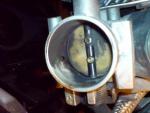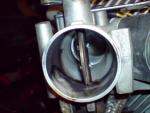-
Posts
1,561 -
Joined
-
Last visited
-
Days Won
2
Content Type
Profiles
Forums
Events
Gallery
Community Map
Everything posted by raz
-
I agree, I friend of mine had sympthoms very similar to yours and it went away when swapping relays. Note that you could swap all similar relays around to check it out quick. Then, if that was it, replace ALL of them because Dan's (or Ryland3210's) is cheap and stock relays are flaky. Both of them will ship to Greece and postage is not much since it fits in an envelope.
-
Maybe good old Luigi ran out of assembly lube and decided to use vinegar instead? If the shim and it's mating surface was flat enough it could take some time before enough oil got in there. Anyway if you're worried I guess four shims will cost almost nothing and you could probably sand down the supports in no time. Then YOU use assembly lube when putting it together. I wouldn't stop riding while waiting for parts though. Note: I am just a couple of years ahead of you, so sanding the supports is an idea and not a professional advice :!:
-
Your fuel pump is inside the tank, but is the pressure regulator too? Mine is not, it's on the right side of the tank. The V11's I know of look like mine in that aspect.
-
I agree it's not proven but the few reports I've heard are positive. Also, some FWIW facts: The WHB (both yours and mine) says it should be connected. It's never pictured and it's not in the parts manual but still, it is clearly in the text (using the word 'must'). In the generation before mine, it was pictured too, routed to both manifolds. Connecting it will not result in richer mixture at any time, just leaner at low load. The specs for the injector says it will atomise the fuel forming a cone of 30° at a fuel pressure of 3±0.2 bar (44±3 psi). This must be referenced to where it injects to, not free air. Without connecting this hose we will get well out of this range at certain conditions and the way I read it, this may result in bad atomising at low load or decel. Edit: The striked-out sentence is probably wrong, as discussed below. Anyway I have ordered what I need to do this mod. and I will report back.
-
The good news is that this washer only protects the outer bearing from dirt (it is not even very good at that). When everything is tightened up, I can still rotate the washer. So the wheel/bearings are still properly torqued up. Be sure to grease that bearing while you are at it.
-
+1 on that, Scotch. So we are almost 200% sure now
-
Found most answers myself, when reading the english WHB pdf instead of a crappy paper copy in german. Less than 7.5 mm plates should be replaced. I'm pretty sure the 0.3 mm warp is bad and I'll replace it anyway. Oh, and apparently the same plates can be used from 1989 and up to V11 at least.
-
Fair enough, it is a bodge and it works like a charm. Now I propose we end this here. But I'll be happy to discuss other sensor concepts in a brand new thread. I just re-read this one wondering how we ended up having this conversation in this thread and one thing I noticed is our latest ideas are not fixing our initial concerns cheers
-
Nah, I think the map should really take care of that. When you flog it you will use upper/right parts of the map, which should be tuned for power. When droning you will use the middle/left parts, which should be tuned for economy. A good map has practically no downsides in this aspect so you could just make it worse with that potentiometer!
-
To remove the bevelbox from the bike I think you just have to disconnect the torque rod from it (and take the wheel off of course) and pull it rearwards off the rest of the shaft. http://www.v11lemans.com/forums/index.php?...ost&p=21056 second pic is the bearing I meant. Very prone to rust and failure. You can reach it (even for replacing) from the outside. If you need to replace it (mine was just rust and trash) don't buy a ridiculously priced OEM but find a standard HK 2516-2RS. The inner race is sold separately, IRZ 20x25x18. Another thread on bevel box: http://www.v11lemans.com/forums/index.php?showtopic=9794 Got a Workshop Manual? Downloadable for free in various places. Also, use the forum's search function, this site holds huge amounts of great information.
-
Having suspected my clutch for some time, today I whacked the engine out of the frame and disassembled it. Seems to me it's worn out and the intermediate plate is warped. Thought I'd check the details with you lot. Bike has 55,000 kms on it. 10-spring clutch. Friction plates are riveted type, rivets seem good but total thickness is about 7.4 mm. The "protrutions" in the friction material is only some 0.3 mm at the worst places. If I put the intermediate plate on a flat surface, I can fit a 0.3 mm feeler gauge under its' outer area (or inner if I put the other side down) All splines look and feel like new (made me feel happier) So... The plates are end-of-life, right? I saw somewhere for a V11 they are out if they come anywhere near 7 mm. The 0.3 mm "convex", that is the warped intermediate plate you use to talk about, right? Did the warped plate cause more wear? I haven't noticed any slip, just a very deep engaging point (almost failed to release completely with lever fully in) that I failed to adjust to the better. I'm not interested in lightening the clutch but I certainly would appreciate lighter operation. Would a single plate clutch do me any good? As long as I just replace plates and intermediate, are these just the standard "big block since 1989" ones despite I seem to have other part numbers in my parts manual?
-
I noticed an odd thing when tearing the engine to pieces. The air filter side of the TB's has got some sort of deposits inside. Looks almost like carbon but it's much thinner. It ends right at the butterfly. What the heck is it? There's only filtered air here! Could it be from backfiring? I had a lot of that just after I bought it.
-
If you're really looking for stuff to give TLC, check the bevel box RH outer bearing. It's a weak little needle bearing without much protection from water. Clean and grease at every opportunity.
-
Yeah that is the gist of it. I think one of the Right Things you could do with this is what Cliff does. Treat anything above 50°C as "we do not need a choke". Still, I'm interested in whatever quick'n'dirty fix you could do to make the OEM happy. The potentiometer solution, while fool-proof, is down right ugly.
-
It is called "oil temperature sensor" in WHBs (like the one for V11sport) and other publications but that may be for historical reasons. I was thinking about putting a sensor in the sump but that could show too warm instead. Imagine a real hot bike being parked in cold rain and wind for a while. Oil in sump will still be pretty warm but cylinder heads pretty cool. So we want cylinder head temperature of some sort but a "real" CHT sensor (like a ring replacing the spark plug gasket) would probably be overkill, and anyway it is not a plug in replacement. This thread (1st reply) show an interesting alternative: http://guzzitech.com/PHPBB2/viewtopic.php?t=922 Apparently the commercial item is very expensive but you could DIY by just epoxying the NTC to your blanking plug.
-
No, that was what I meant. But on the other hand, I was wrong . Before engaging in a fight with you I looked at a datalog from a ride in some 10°C and the oil temp from sensor actually dropped from 80°C to 60°C pretty quick. As soon as I stopped it started climbing again. I usually don't ride when it's that cold and I had the impression a reading taken while riding (I can see the sensor temp with Cliff's Optimiser) would match the dipstick. But apparently it can be real bad!
-
Not mine anyway. I have a dipstick thermometer in the sump and it usually reads pretty much the same as the temp sensor.
-
As long as you don't turn this supposed oil temp sensor into a cylinder head temp sensor I can't see how you would overheat it. If you experience 150°C oil temp you might want to check your oil cooler thermostat. My guess is only a series of dyno runs would get you there. The operating range (and the table) probably just means that the reading above 125°C is less predictable. It will still be lower resistance at higher temp and I would expect the oil to suffer from overheat long before the sensor does. I'm not sure about WM1.5 but a stock WM1.6 will do the same correction at 150°C (or higher) as it will at 113°C. At temps over 65°C there is a wierd negative correction. FWIW Cliff's MyECU stock table will stop correcting at 50°C, it never goes negative but just zero. You are right about the conductive goo will help cooling too. The 1100 Sport sensor is probably better. It sits in the LH valve cover and the bare NTC gets splashed with oil all the time. Are we hijacking this thread? Maybe we should move.
-
Don't count on three-digit x 12 figures... but count me in! Also, be sure to spread the word in other territories, like http://morini.com.au/phpBB2/
-
The only purpose of that sensor is to tell the ECU what temperature (ballpark) the engine has so the ECU can figure out if it needs to boost the fuel (like a good old choke). I'm not sure what you mean, would you like to target the center of that table? Why? I'm pretty sure the exact output (like 84°C or 92°C) is not important at all, but speed is. If the engine is warm the ECU should know about it. The ECU is NOT interested in having the reading severly lowered by rain and cold wind. That will result in unnecessary fuel boost.
-
Can't blame them, they looked at the title... and posted a hijack Regarding the other thread, don't take it personally. It drifted away. Sometimes it just happens. Most of the time I don't see we have a big problem with hijacked threads on this forum.
-
Well I pay about US$ 7.50 for a gallon of fuel so better mileage is always welcome. But as I said, cabin fever might be a more proper explanation. 0.30" is more than the M6 threaded hole it's fitted to... maybe you mean 0.03" ?
-
That's strange. It really should make SOME difference I would have thought. I trust your words enough to be sure you didn't screw up in any way. But did you try it long enough to see if your mileage changed to the better? I'm pretty sure it could lower the fuel consumption right in the areas you wont notice any downsides of it. But that's just from cabin fever theory of course... The narrow passages, is that in the nipples? Maybe wider ID nipples should be used for this application.
-
This reminds me of a poem. Sweden, land of Volvo cars Prisons without bars Whole towns without bars Heh, that's it in a nutshell.





